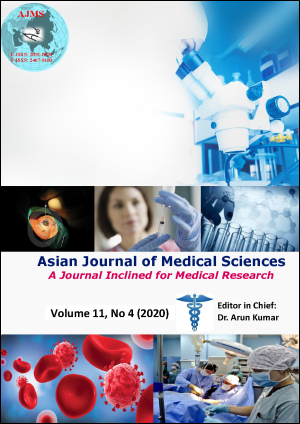Study of cord blood albumin as a predictor of neonatal jaundice
Keywords:
Cord blood albumin level, Neonatal HyperbilirubinemiaAbstract
Background: Neonatal jaundice is a commonly encountered condition in the neonates during first week of life. Early discharge of healthy term newborns is a common practice, because of the risk of nosocomial infections, social causes like in early naming ceremony, and also due to economical constrains. In significant number of newborns, neonatal hyperbilirubinemiais the most common cause for readmission. There is concern regarding early discharge of healthy term newborns due to reports of bilirubin induced brain damage resulting in sequel like kernicterus .There are reports of bilirubin induced brain damage which occurred in healthy term neonates even without hemolysis and the clinical outcome could be serious. The need for early detection of hyperbilirubinemia in the newborns is therefore important.
Aims and Objective: The objective of the study was to find whether cord blood albumin can be considered as a predictor of neonatal jaundice. The study also explored for any possible associations of different factors like gender, birth weight and mode of delivery with the occurrence of neonatal jaundice.
Materials and Methods: The hospital based cross sectional study enrolled 100 healthy term newborns from August 2016-July 2017. Cord blood was sent for albumin level and blood group estimation. All babies were assessed for clinical jaundice using Krammer criteria and confirmed by estimation of total serum bilirubin level on the fourth day of life.
Results: Correlation of cord blood albumin with the fourth day bilirubin level revealed negative correlation (r value of - 0.455) with p value of 0.000 which was highly significant. However, there was no correlation between cord blood albumin level with total serum bilirubin level of more than 17mg/dl (neonatal hyperbilirubinemia) that required phototherapy or exchange transfusion (p value of >0.005). Similarly, the study found no statistically significant association of neonatal jaundice with gender, weight and mode of delivery of the neonates.
Conclusion: Cord blood albumin can be a risk factor rather than a diagnostic tool which can give a clue to possibility of high bilirubin level during neonatal period. There was no statistical significance seen between cord blood albumin level with total serum bilirubin level of ≥ 17mg/dl (neonatal hyperbilirubinemia) that required phototherapy or exchange transfusion.
Downloads
Downloads
Published
How to Cite
Issue
Section
License
Authors who publish with this journal agree to the following terms:
- The journal holds copyright and publishes the work under a Creative Commons CC-BY-NC license that permits use, distribution and reprduction in any medium, provided the original work is properly cited and is not used for commercial purposes. The journal should be recognised as the original publisher of this work.
- Authors are able to enter into separate, additional contractual arrangements for the non-exclusive distribution of the journal's published version of the work (e.g., post it to an institutional repository or publish it in a book), with an acknowledgement of its initial publication in this journal.
- Authors are permitted and encouraged to post their work online (e.g., in institutional repositories or on their website) prior to and during the submission process, as it can lead to productive exchanges, as well as earlier and greater citation of published work (See The Effect of Open Access).




